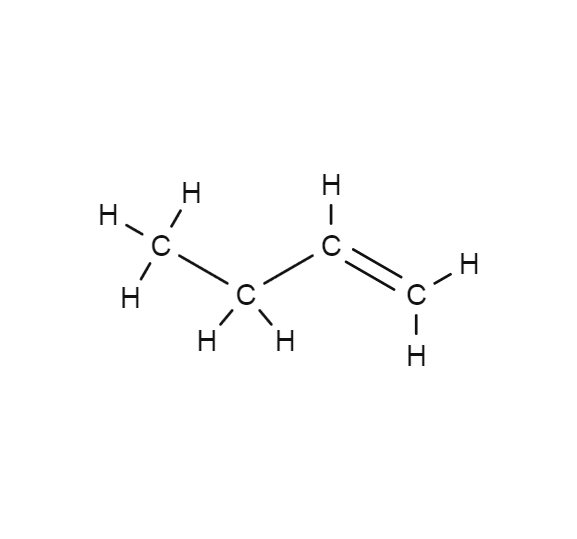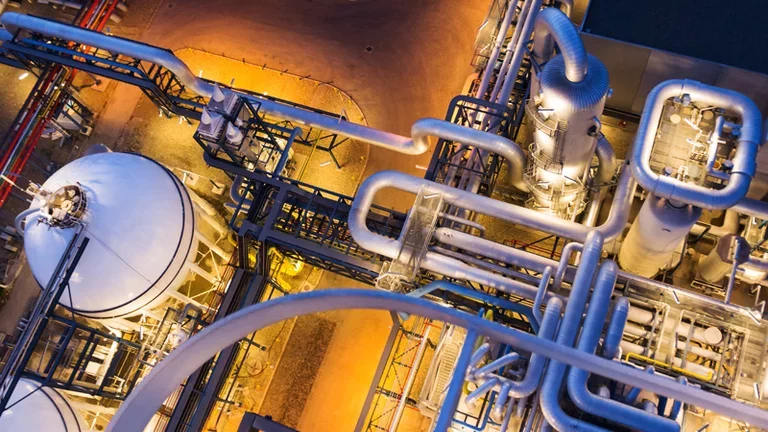
1-Butene
- C4H8
- CAS Number 106-98-9
- UN1012 (gas)
Click & drag to move the 3D molecule
Liquid / Gas Volumes
Calculate the volume or mass of a quantity of gas or liquid
Liquid Phase
At boiling point at 1.013 bar
Gas Phase
In standard conditions (1.013 bar, 15°C)
Physical Properties
Molecule phase diagram showing the transition phases between solid, liquid and gas as a function of temperature and pressure
-
- Molar mass 56.106 g/mol
- Content in dry air /
-
Critical Point
- Temperature 146.35 °C
- Pressure 40.2 bar
- Density 232.81 kg/m³
-
Triple Point
- Temperature -185.35 °C
- Pressure 0 bar
Pressure 1.013 bar
| Latent heat of fusion (at melting point) | 68.584 kJ/kg |
| Melting point | - 185.35 °C |
Pressure 1.013 bar
| Boiling point | - 6.31 °C |
| Latent heat of vaporization (at boiling point) | 392.23 kJ/kg |
| Liquid density (at boiling point) | 625.63 kg/m3 |
| Compressibility factor Z | 9.6146E-1 |
| Cp/Cv ratio γ | 1.1389 |
| Gas density (at boiling point) | 2.675 kg/m3 |
| Gas density | 2.6029 kg/m3 |
| Gas/(liquid at boiling point) equivalent | 240.36 vol/vol |
| Heat capacity Cp | 1.4905 kJ/(kg.K) |
| Heat capacity Cv | 1.3087 kJ/(kg.K) |
| Specific gravity | 1.93 |
| Specific volume | 3.842E-1 m3/kg |
| Thermal conductivity | 14.505 mW/(m.K) |
| Vapor pressure | 1.2912 bar |
| Viscosity | 7.4354E-5 Po |
| Compressibility factor Z | 9.6845E-1 |
| Cp/Cv ratio γ | 1.1284 |
| Gas density | 2.4496 kg/m3 |
| Gas/(liquid at boiling point) equivalent | 255.4 vol/vol |
| Heat capacity Cp | 1.5305 kJ/(kg.K) |
| Heat capacity Cv | 1.3564 kJ/(kg.K) |
| Specific gravity | 1.93 |
| Specific volume | 4.082E-1 m3/kg |
| Thermal conductivity | 15.939 mW/(m.K) |
| Vapor pressure | 2.1976 bar |
| Viscosity | 7.8728E-5 Po |
| Compressibility factor Z | 9.7213E-1 |
| Cp/Cv ratio γ | 1.1225 |
| Gas density | 2.3584 kg/m3 |
| Gas/(liquid at boiling point) equivalent | 265.28 vol/vol |
| Heat capacity Cp | 1.5606 kJ/(kg.K) |
| Heat capacity Cv | 1.3902 kJ/(kg.K) |
| Solubility in water | 9.41E-2 mol/mol |
| Specific gravity | 1.93 |
| Specific volume | 4.24E-1 m3/kg |
| Thermal conductivity | 16.934 mW/(m.K) |
| Vapor pressure | 3.026 bar |
| Viscosity | 8.1625E-5 Po |
Applications
Examples of uses of this molecule in Industry and Healthcare

Chemicals
1-Butene is used as a co-monomer for the production of high density (HDPE) and linear low density (LLDPE) polyethylene products and for the manufacture of polybutylene. 1-Butene is also used as feedstock for the production of 1,2-butylene oxide, methylethylketone (MEK), maleic anhydride and n-butyl derivatives. Butene-1 has good solvent properties.
Safety & Compatibility
GHS02
Flammable
Autoignition Temperature, Flammability Limits & Flash Point
Europe (according to EN1839 for Limits and EN 14522 for autoignition temperature)
| Autoignition temperature (Chemsafe) | 360 °C |
| Lower flammability limit (IEC 80079-20-1) | 1.5 vol% |
| Upper flammability limit (IEC 80079-20-1) | 10.6 vol% |
US (according to ASTM E681 for Limits and ASTM E659 for autoignition temperature)
| Autoignition temperature (NFPA 325) | 385 °C |
| Lower flammability limit (NFPA 325) | 1.6 vol% |
| Upper flammability limit (NFPA 325) | 10 vol% |
Odor
Slightly aromatic
Metals
| Aluminium | Satisfactory |
| Brass | Satisfactory |
| Monel | No data |
| Copper | No data |
| Ferritic Steel | Satisfactory |
| Stainless steel | Satisfactory |
| Zinc | No data |
| Titanium | No data |
Plastics
| Polytetrafluoroethylene | Satisfactory |
| Polychlorotrifluoroethylene | Satisfactory |
| Polyvinylidene fluoride | Satisfactory |
| Polyvinyl chloride |
Significant swelling, change of mechanical properties
Not recommended
|
| Ethylene tetrafluoroethylene | No data |
| Polycarbonate | No data |
| Polyamide | Satisfactory |
| Polypropylene | Satisfactory |
Elastomers
| Butyl (isobutene- isoprene) rubber |
Significant swelling and modification of the properties of the material
Not recommended
|
| Nitrile rubber | Satisfactory |
| Chloroprene |
Significant swelling
Not recommended
|
| Chlorofluorocarbons | No data |
| Silicone |
Significant swelling and modification of the properties of the material
Not recommended
|
| Perfluoroelastomers | Satisfactory |
| Fluoroelastomers | Satisfactory |
| Neoprene | No data |
| Polyurethane |
Significant swelling, change of mechanical properties
Not recommended
|
| Ethylene-Propylene |
Significant swelling and modification of the properties of the material
Not recommended
|
Lubricants
| Hydrocarbon based lubricant |
Significant loss of mass
Not recommended
|
| Fluorocarbon based lubricant | Satisfactory |
Materials compatibility
Learn More
More information
1-Butene, also known as butylene, is an alkene with the formula C4H8. It is a gas at room temperature and pressure, but can be liquefied by lowering the temperature or raising the pressure on it, in a manner similar to pressurised butane. This gas is colourless, highly flammable with no distinct odour. Although not naturally present in petroleum in high percentages, it can be produced from petrochemicals or by catalytic cracking of petroleum.